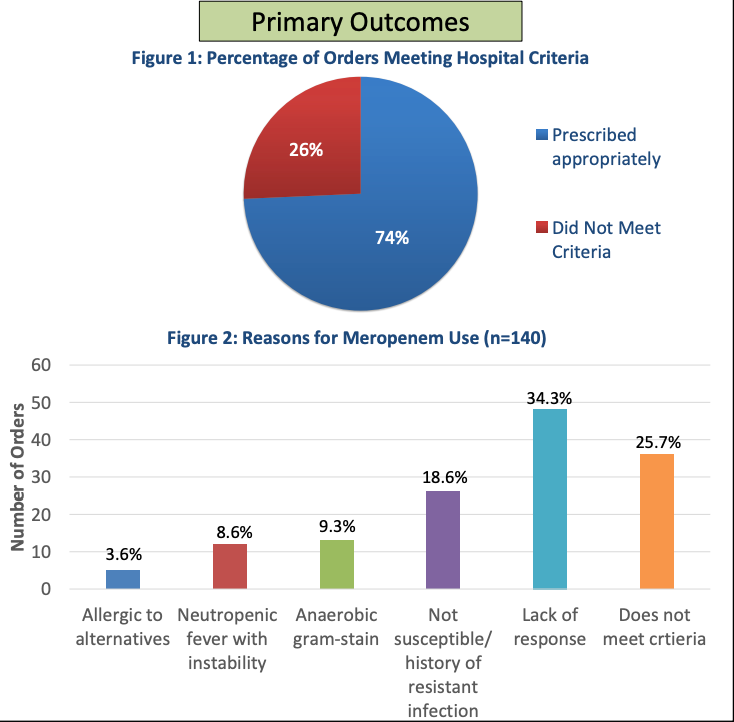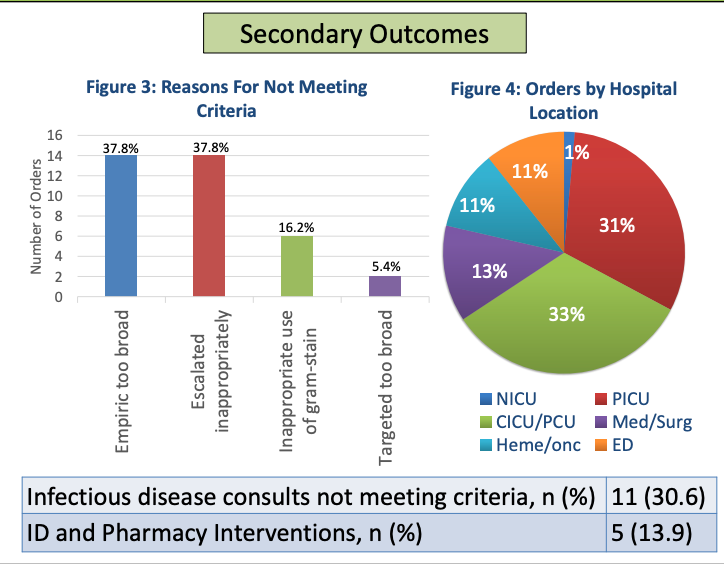Infectious Diseases
Infectious Diseases 4
421 - Evaluation of Meropenem use at a Pediatric Academic Medical Center
Publication Number: 421.418

Navjyot K. Vidwan, MD MPH (she/her/hers)
Associate Professor
University of Louisville/Norton Children's Hospital
Louisville, Kentucky, United States
Presenting Author(s)
Background:
Meropenem is a broad-spectrum antibiotic and its use is critical for extended spectrum beta-lactamase (ESBL) producing bacteria. It needs to be reserved for specifically indicated patients without alternative antibiotic choices. At our institution our antimicrobial stewardship program (ASP) and pharmacy developed a “best
practice” alert (BPA) upon ordering meropenem that details the criteria for use of this agent and options for alternative antibiotics. The ASP goal is for meropenem to only be used as targeted therapy against EBSL infections and not for empiric use.
Objective: The primary objective: determine the percentage of meropenem orders that were prescribed correctly according to hospital guidelines detailed in the BPA. Secondary objectives: determine ASP information from the BPA: reasons for not meeting prescribing criteria; the number of infectious disease (ID)consults recommended; areas of hospital that meropenem was being ordered, number of interventions made on the orders that didn't meet criteria.
Design/Methods: A retrospective chart review was performed analyzing all initial orders placed for meropenem : January 2020–October 2021. Patients admitted to any unit at NCH and ≤ 21 years were included.
Results: There were 88 patients that were included in the study with 140 initial first time meropenem orders. The ID team was consulted on 47.9% of all initial orders and the majority came from the CICU (32.9%) and PICU (31.4%). 26.4% initial orders did not meet criteria for ordering meropenem and ID was consulted on 29.7% of those orders. ID and pharmacy intervened and changed the patient to the correct therapy on 13.5% of orders that did not meet initial criteria. Reasons for not meeting criteria included ordering too broad empirically, escalating inappropriately, not following institutional blood culture reporting workflow, and targeted therapy ordered inappropriately.
Conclusion(s):
Providers at NCH ordered meropenem correctly according to the institutional criteria 73.6% of the time. A meropenem BPA was helpful in screening meropenem use in our hospital.The BPA allowed us to monitor if our institutional ASP guidelines were being followed and what the indication of use was. However, we found that we will likely need to change one of our BPA meropenem use categories “lack of response to alternative therapy” to a more specific indication as this represented the largest indication/category of use. ID consults were found to be helpful for both appropriate and inappropriate meropenem initial use indications. 

